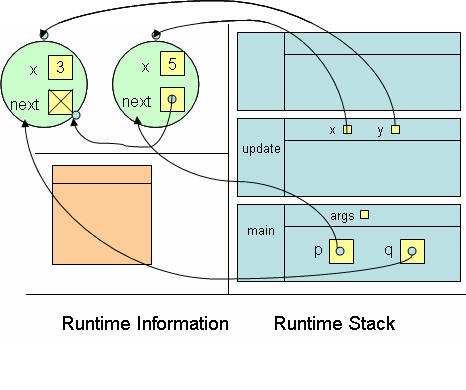
Q0. [0 points] The Dilbert Zone

Q1. [12 points] This question tests your basic knowledge of the Java for statement. When the following method executes, what are the final values of x and y printed out? [At the underlined statement, you must show the intermediate values for x and y, otherwise you only get 1/2 credit].
Answers: I expected students to tell me the value of x,y immediately before the statement executed (but I was willing to accept answers that were consistent with 'just after'). Here are the results. note that the values that are output ARE NOT the same as the last two entries. This question tested (a) understanding of the way in which a for loop executes; (b) integer division; (c) the knowledge that the advance statement (y--) within a for loop happens after the body executes and BEFORE the condition is evaluated.
| public void f() { int x = 5; int y = x; for (x = 6; y < x; y--) { x = x/2 + y; } System.out.println (x + "," + y); } |
|
Q2. [20 points] There are at least five logical errors in the following code that compiles successfully. The code is supposed to print “(100,100) is inside: false” but it instead prints out "(100,100) is inside: true". Circle the errors and suggest changes to make it work. You may suggest new lines of code to add, or suggest lines of code to remove.
Answer:
| public class Square { /** Upper left corner point. */ int x; int y; /** Width and height of square. */ int unit; /** Construct Square from upper * left (x,y) and lower right (x2,y2). */ public Square (int x, int y, int x2, int y2) { // compute constants for Square. x = x; y = y; unit = x-x2; } /** Determine if point is contained * within Square (even on an edge). */ public boolean inside (int u, int v) { return (x <= u) && (u-unit >= x) && (y <= v) && (v-unit >= y); } } |
public class Exam { public static void main (String []ss) { // Create the Square Square sq = new Square (20, 40, 90, 120); // see if point is inside. System.out.println ("(100,100) is inside: " + sq.inside(100,100)); } } |
Q3. [18 points] Given the following code, fill in the stack frame diagram on the right with the appropriate references, either static or point to this. For all variables and parameters include values or references as appropriate. Show objects on the heap as well. Note that the program is stopped at the underlined code.
| public class Q2 { int top; int val; public Q2 (int x) { top = x; val = 0; } public void
process (int [] ar) { |

|
Q4. [24 points] This question tests your knowledge of procedural
abstractions. The authors of the book introduce the following concept regarding the
properties of procedures and their implementation.
Minimality -- one specification is more minimal than another if it
contains fewer constraints on allowable behavior.
You are given the following three specifications for a method 'void f(int []ar)'.
| Specification A | REQUIRES: ar != null MODIFIES: ar EFFECTS: ar contains descending order of ints |
| Specification B | REQUIRES: ar != null MODIFIES: ar EFFECTS: rearranges the elements of ar to be a random permutation of ar. |
| Specification C | REQUIRES: ar != null MODIFIES: ar EFFECTS: rearranges the elements of ar into descending order. |
a) [8 points] Is SpecB more minimal than SpecA? Explain your answer
[otherwise you only get 1/2 credit]
b) [8 points] Is SpecC more minimal than SpecA? Explain your answer
[otherwise you only get 1/2 credit]
c) [8 points] Which Specification does the following implementation match
most clearly. Explain your answer [otherwise you only get 1/2 credit]
Answer: Some observations: (1) Specification A says nothing about the relationship between the values of ar before the method is called and the values that are left in ar after the method is called. A function that satisfies this specification simply overwrites the actual contents of the array with values {0, -1, -2, -3, -4, ...} for the entire size of the array. (2) While Specification B states that the array simply be a random permutation (i.e., shuffle) of existing elements within the array, specification C declares that the integers must be sorted in descending value.
Now, given these observations:
(a) Specification B is not more minimal than Specification A. Functions
that conform to Specification B are restricted to only modify the 'ar' array to contain a
permutation of the original elements; functions that conform to Specification A are only
restricted by the requirement that the numbers that ultimately appear in ar are in
descending order.
(b) Specification C is not more minimal than Specification A.
Specification C is deterministic in that it can return only a single result given input
array 'ar', namely, the original array sorted in descending order. Specification A (again)
has much fewer constraints on the allowed behavior of the functions that conform to the
Specification.
(c) If you look at the code below, the function f() can be best called 'randomSort'. It
randomly selects items from the array, swaps them, and checks to see if the array has been
sorted into descending order. Thus this code most closely conforms to Specification C
[even though there is a random permutation, the final result is restricted as with
Specification C; also, while Specification A also produces descending integers, they may
have nothing to do with input parameters, thus we select Specification C as the best one.
| public void f(int []ar) { boolean b = true; while (b) { int r1 = selectRandom(0,ar.length-1); // randomly select from 0,1,...,ar.length-1 int r2 = selectRandom(0,ar.length-1); // randomly select from 0,1,...,ar.length-1 int tmp = ar[r1]; ar[r1] = ar[r2]; ar[r2] = tmp; // swap ar[r1] with ar[r2] b = false; for (int i = 0; i < ar.length-1; i++) { if (ar[i] < ar[i+1]) { b = true; break; } } } } |
Aside: For the curious, what is the performance of this random sort? Well, given that it is non-deterministic, the following values should be taken as only a single data point, not reflecting the total time to sort arbitrary arrays. All time is in milliseconds and performed on a ~400 Mhz machine. Naturally, one would not want to use this algorithm to sort! note how it took about 1 Hour to sort 8 elements at random.
| SIZE | InsertionSort | RandomSort |
| 2 | 0 | 0 |
| 3 | 0 | 0 |
| 4 | 0 | 8,223 |
| 5 | 0 | 95 |
| 6 | 0 | 495 |
| 7 | 1 | 498 |
| 8 | 0 | 3,604,632 |
Q5. [2 points] Fill in the following Dilbert cartoon. Extra points if I fall out of my chair laughing.

Q6. [24 Points] This question test your knowledge of how to manipulate object references. Assume that you are given the following LinkedList class and a companion Node class.
| LinkedList | Node |
| public class
LinkedList { // first element Node head; public
LinkedList () {
|
public class
Node { // Value int value; // next Node next; // constructor |
Assume that the other methods (not shown here) of LinkedList properly build up a linear LinkedList of Node objects.
(a) [10 points] Write the specification for a method 'void remove(int i)' for the LinkedList class which
removes the first Node from the LinkedList whose value is i.
(b) [14 points] Write the Java implementation for this specification.
| /** * Remove from the LinkedList any Node whose int value is * equal to target. * MODIFIES: this * EFFECTS: Ensures that LinkedList contains no Node * whose int value is 'target'. */ public void remove (int target) { // handle empty list case. Done immediately, so return. if (head == null) { return; } // if 'target' is the head of the LinkedList, simply // redirect to second. Note: this may result in an // empty list. if (head.value == target) { head = head.next; return; } // find if
we are already in the list. We must work |